Decline of Strike Activities in Britain
VerifiedAdded on 2020/07/23
|13
|3173
|27
AI Summary
The provided document discusses the decline of strike activities in Britain, attributing it to a combination of primary and secondary factors. The primary factors include the Thatcher administration's reforms, the defeat of unions, post-war boom, and deflation. These laid the foundation for secondary forces such as increasing individualism and globalization, which had a significant impact on workplace disputes. The document references various studies and research papers to support its claims, highlighting the importance of formal procedures in resolving conflicts and the decline of strike activities.
Contribute Materials
Your contribution can guide someone’s learning journey. Share your
documents today.
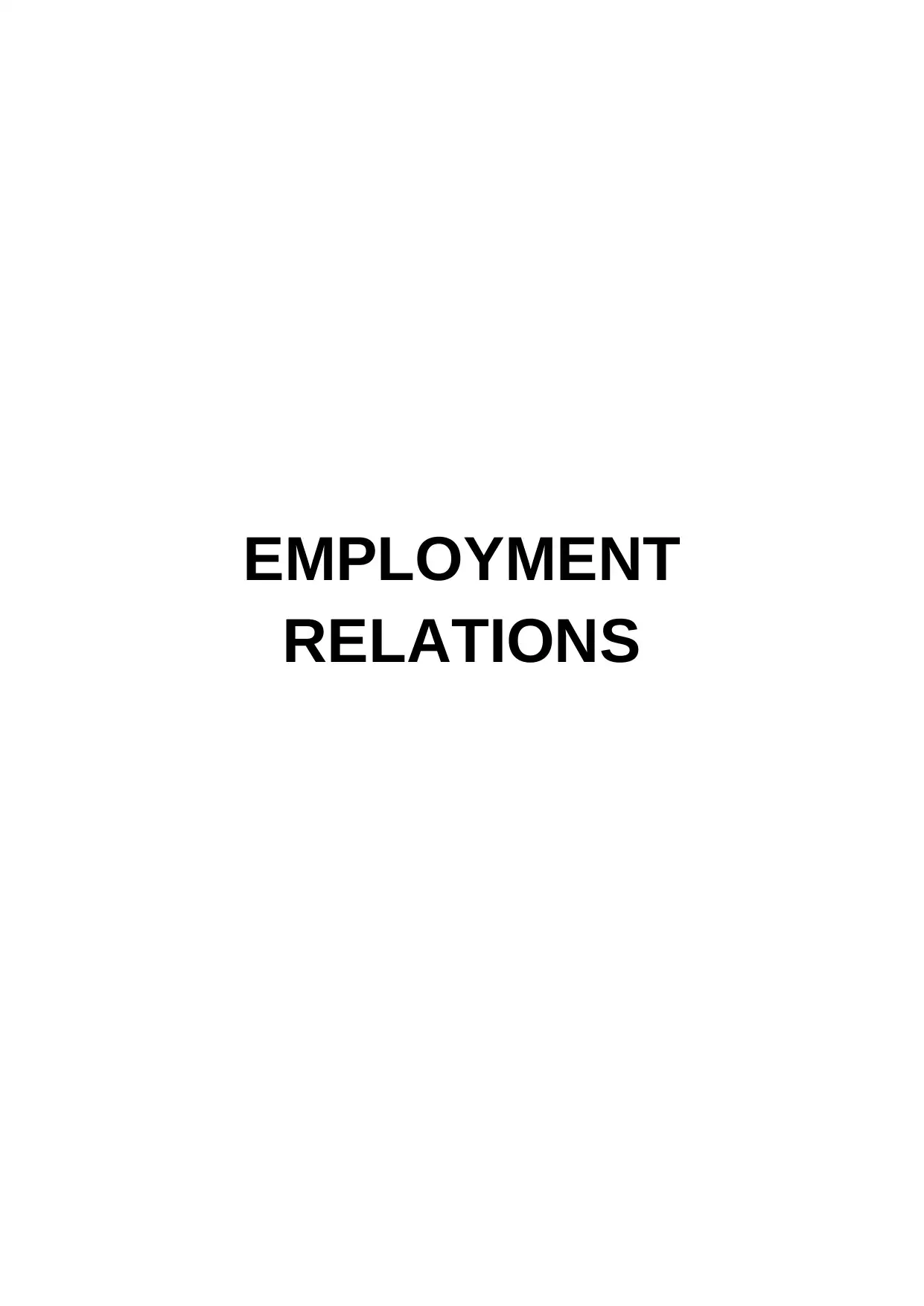
EMPLOYMENT
RELATIONS
RELATIONS
Secure Best Marks with AI Grader
Need help grading? Try our AI Grader for instant feedback on your assignments.

Contents
INTRODUCTION.....................................................................................................................................2
LEGISLATIONS DURING THE ADMINISTRATION OF THATCHER..............................................................3
THE POST WAR BOOM ..........................................................................................................................6
DEFEAT OF OBSTINATE UNIONS............................................................................................................7
TRADE LIBERALISATION AND GLOBALISATION......................................................................................8
INCREASING RISE OF INDIVIDUALISM....................................................................................................9
THE ROLE OF INSTITUTIONS.................................................................................................................10
CONCLUSION.......................................................................................................................................11
REFERENCES.........................................................................................................................................12
INTRODUCTION.....................................................................................................................................2
LEGISLATIONS DURING THE ADMINISTRATION OF THATCHER..............................................................3
THE POST WAR BOOM ..........................................................................................................................6
DEFEAT OF OBSTINATE UNIONS............................................................................................................7
TRADE LIBERALISATION AND GLOBALISATION......................................................................................8
INCREASING RISE OF INDIVIDUALISM....................................................................................................9
THE ROLE OF INSTITUTIONS.................................................................................................................10
CONCLUSION.......................................................................................................................................11
REFERENCES.........................................................................................................................................12
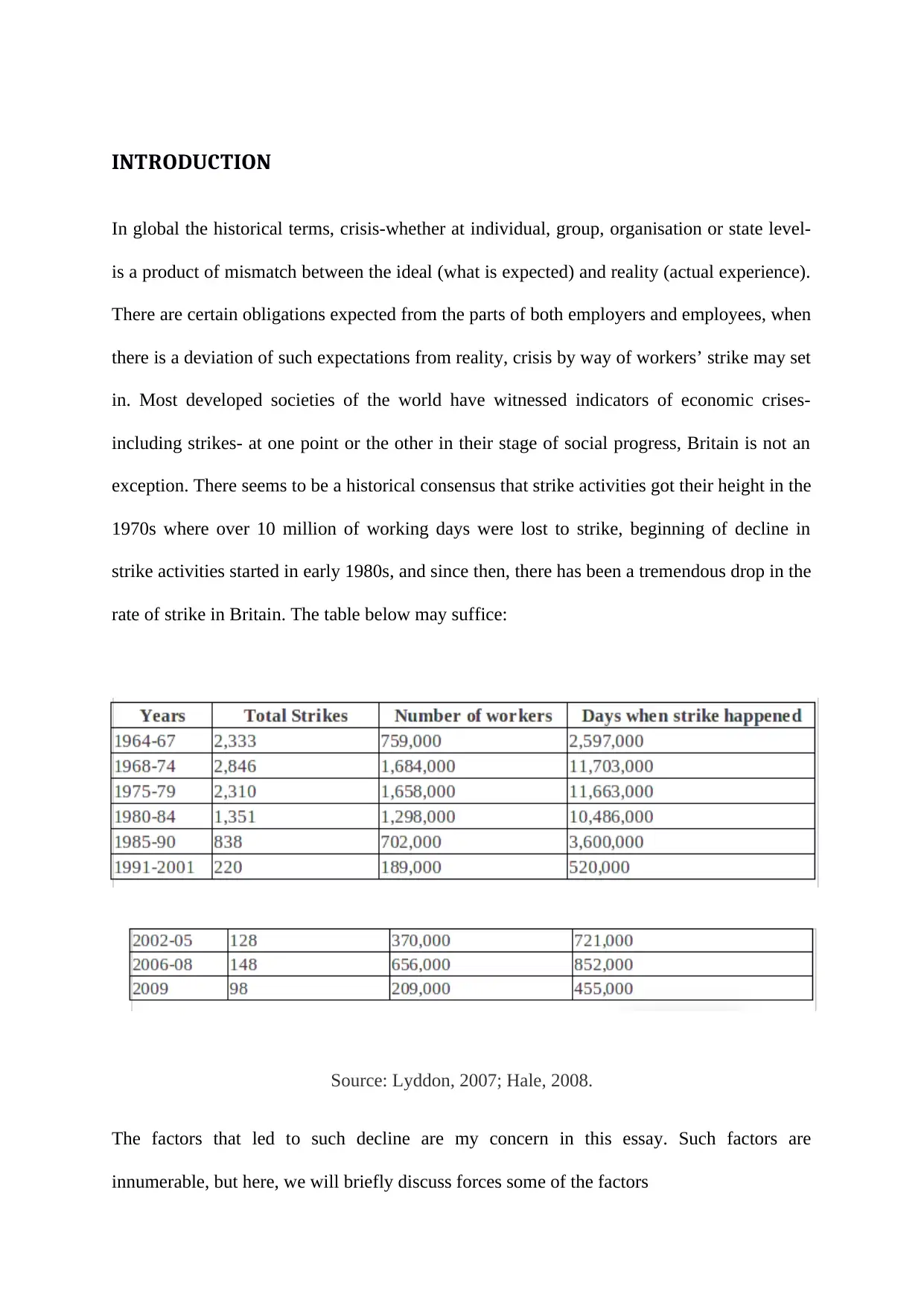
INTRODUCTION
In global the historical terms, crisis-whether at individual, group, organisation or state level-
is a product of mismatch between the ideal (what is expected) and reality (actual experience).
There are certain obligations expected from the parts of both employers and employees, when
there is a deviation of such expectations from reality, crisis by way of workers’ strike may set
in. Most developed societies of the world have witnessed indicators of economic crises-
including strikes- at one point or the other in their stage of social progress, Britain is not an
exception. There seems to be a historical consensus that strike activities got their height in the
1970s where over 10 million of working days were lost to strike, beginning of decline in
strike activities started in early 1980s, and since then, there has been a tremendous drop in the
rate of strike in Britain. The table below may suffice:
Source: Lyddon, 2007; Hale, 2008.
The factors that led to such decline are my concern in this essay. Such factors are
innumerable, but here, we will briefly discuss forces some of the factors
In global the historical terms, crisis-whether at individual, group, organisation or state level-
is a product of mismatch between the ideal (what is expected) and reality (actual experience).
There are certain obligations expected from the parts of both employers and employees, when
there is a deviation of such expectations from reality, crisis by way of workers’ strike may set
in. Most developed societies of the world have witnessed indicators of economic crises-
including strikes- at one point or the other in their stage of social progress, Britain is not an
exception. There seems to be a historical consensus that strike activities got their height in the
1970s where over 10 million of working days were lost to strike, beginning of decline in
strike activities started in early 1980s, and since then, there has been a tremendous drop in the
rate of strike in Britain. The table below may suffice:
Source: Lyddon, 2007; Hale, 2008.
The factors that led to such decline are my concern in this essay. Such factors are
innumerable, but here, we will briefly discuss forces some of the factors
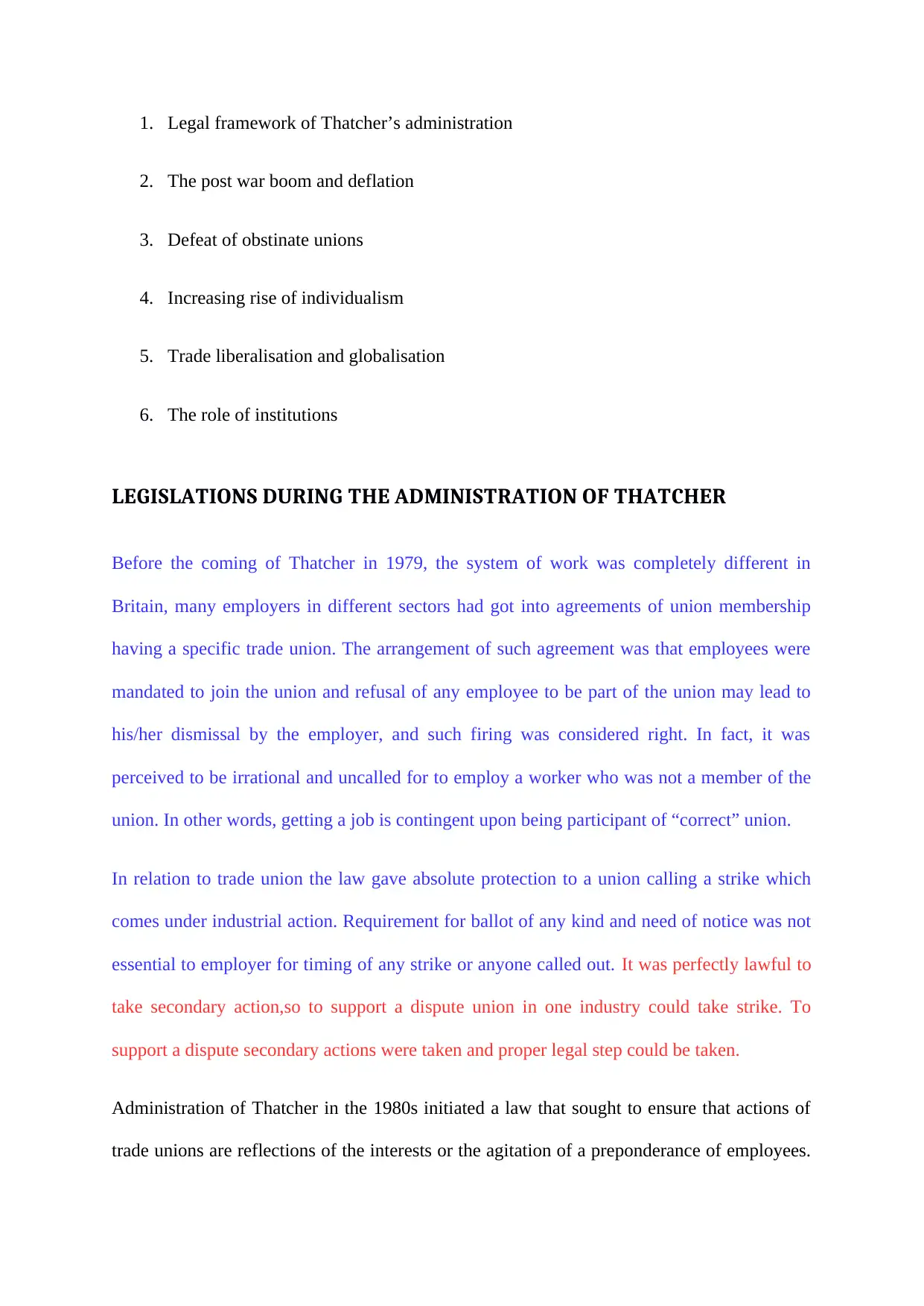
1. Legal framework of Thatcher’s administration
2. The post war boom and deflation
3. Defeat of obstinate unions
4. Increasing rise of individualism
5. Trade liberalisation and globalisation
6. The role of institutions
LEGISLATIONS DURING THE ADMINISTRATION OF THATCHER
Before the coming of Thatcher in 1979, the system of work was completely different in
Britain, many employers in different sectors had got into agreements of union membership
having a specific trade union. The arrangement of such agreement was that employees were
mandated to join the union and refusal of any employee to be part of the union may lead to
his/her dismissal by the employer, and such firing was considered right. In fact, it was
perceived to be irrational and uncalled for to employ a worker who was not a member of the
union. In other words, getting a job is contingent upon being participant of “correct” union.
In relation to trade union the law gave absolute protection to a union calling a strike which
comes under industrial action. Requirement for ballot of any kind and need of notice was not
essential to employer for timing of any strike or anyone called out. It was perfectly lawful to
take secondary action,so to support a dispute union in one industry could take strike. To
support a dispute secondary actions were taken and proper legal step could be taken.
Administration of Thatcher in the 1980s initiated a law that sought to ensure that actions of
trade unions are reflections of the interests or the agitation of a preponderance of employees.
2. The post war boom and deflation
3. Defeat of obstinate unions
4. Increasing rise of individualism
5. Trade liberalisation and globalisation
6. The role of institutions
LEGISLATIONS DURING THE ADMINISTRATION OF THATCHER
Before the coming of Thatcher in 1979, the system of work was completely different in
Britain, many employers in different sectors had got into agreements of union membership
having a specific trade union. The arrangement of such agreement was that employees were
mandated to join the union and refusal of any employee to be part of the union may lead to
his/her dismissal by the employer, and such firing was considered right. In fact, it was
perceived to be irrational and uncalled for to employ a worker who was not a member of the
union. In other words, getting a job is contingent upon being participant of “correct” union.
In relation to trade union the law gave absolute protection to a union calling a strike which
comes under industrial action. Requirement for ballot of any kind and need of notice was not
essential to employer for timing of any strike or anyone called out. It was perfectly lawful to
take secondary action,so to support a dispute union in one industry could take strike. To
support a dispute secondary actions were taken and proper legal step could be taken.
Administration of Thatcher in the 1980s initiated a law that sought to ensure that actions of
trade unions are reflections of the interests or the agitation of a preponderance of employees.
Secure Best Marks with AI Grader
Need help grading? Try our AI Grader for instant feedback on your assignments.
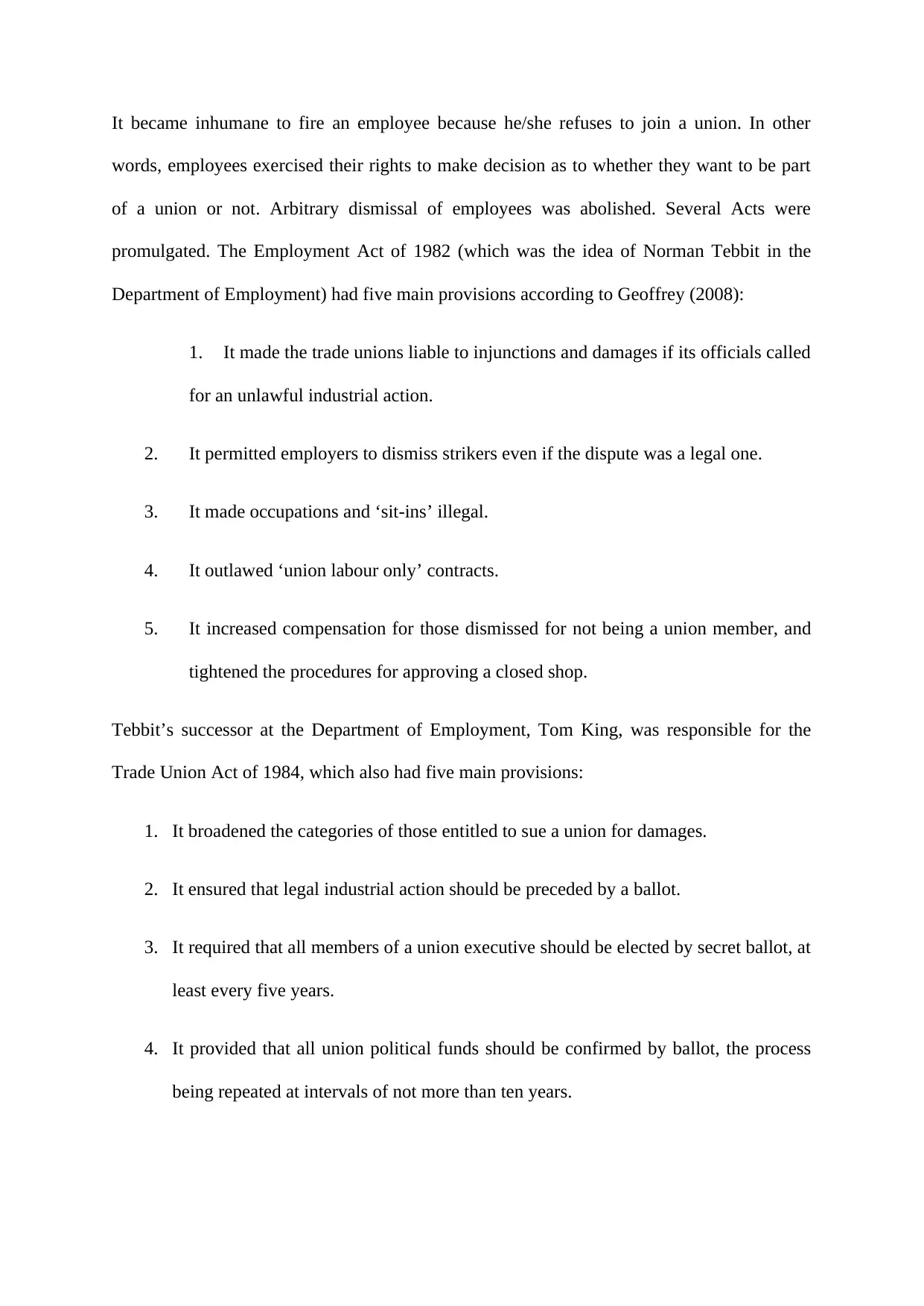
It became inhumane to fire an employee because he/she refuses to join a union. In other
words, employees exercised their rights to make decision as to whether they want to be part
of a union or not. Arbitrary dismissal of employees was abolished. Several Acts were
promulgated. The Employment Act of 1982 (which was the idea of Norman Tebbit in the
Department of Employment) had five main provisions according to Geoffrey (2008):
1. It made the trade unions liable to injunctions and damages if its officials called
for an unlawful industrial action.
2. It permitted employers to dismiss strikers even if the dispute was a legal one.
3. It made occupations and ‘sit-ins’ illegal.
4. It outlawed ‘union labour only’ contracts.
5. It increased compensation for those dismissed for not being a union member, and
tightened the procedures for approving a closed shop.
Tebbit’s successor at the Department of Employment, Tom King, was responsible for the
Trade Union Act of 1984, which also had five main provisions:
1. It broadened the categories of those entitled to sue a union for damages.
2. It ensured that legal industrial action should be preceded by a ballot.
3. It required that all members of a union executive should be elected by secret ballot, at
least every five years.
4. It provided that all union political funds should be confirmed by ballot, the process
being repeated at intervals of not more than ten years.
words, employees exercised their rights to make decision as to whether they want to be part
of a union or not. Arbitrary dismissal of employees was abolished. Several Acts were
promulgated. The Employment Act of 1982 (which was the idea of Norman Tebbit in the
Department of Employment) had five main provisions according to Geoffrey (2008):
1. It made the trade unions liable to injunctions and damages if its officials called
for an unlawful industrial action.
2. It permitted employers to dismiss strikers even if the dispute was a legal one.
3. It made occupations and ‘sit-ins’ illegal.
4. It outlawed ‘union labour only’ contracts.
5. It increased compensation for those dismissed for not being a union member, and
tightened the procedures for approving a closed shop.
Tebbit’s successor at the Department of Employment, Tom King, was responsible for the
Trade Union Act of 1984, which also had five main provisions:
1. It broadened the categories of those entitled to sue a union for damages.
2. It ensured that legal industrial action should be preceded by a ballot.
3. It required that all members of a union executive should be elected by secret ballot, at
least every five years.
4. It provided that all union political funds should be confirmed by ballot, the process
being repeated at intervals of not more than ten years.
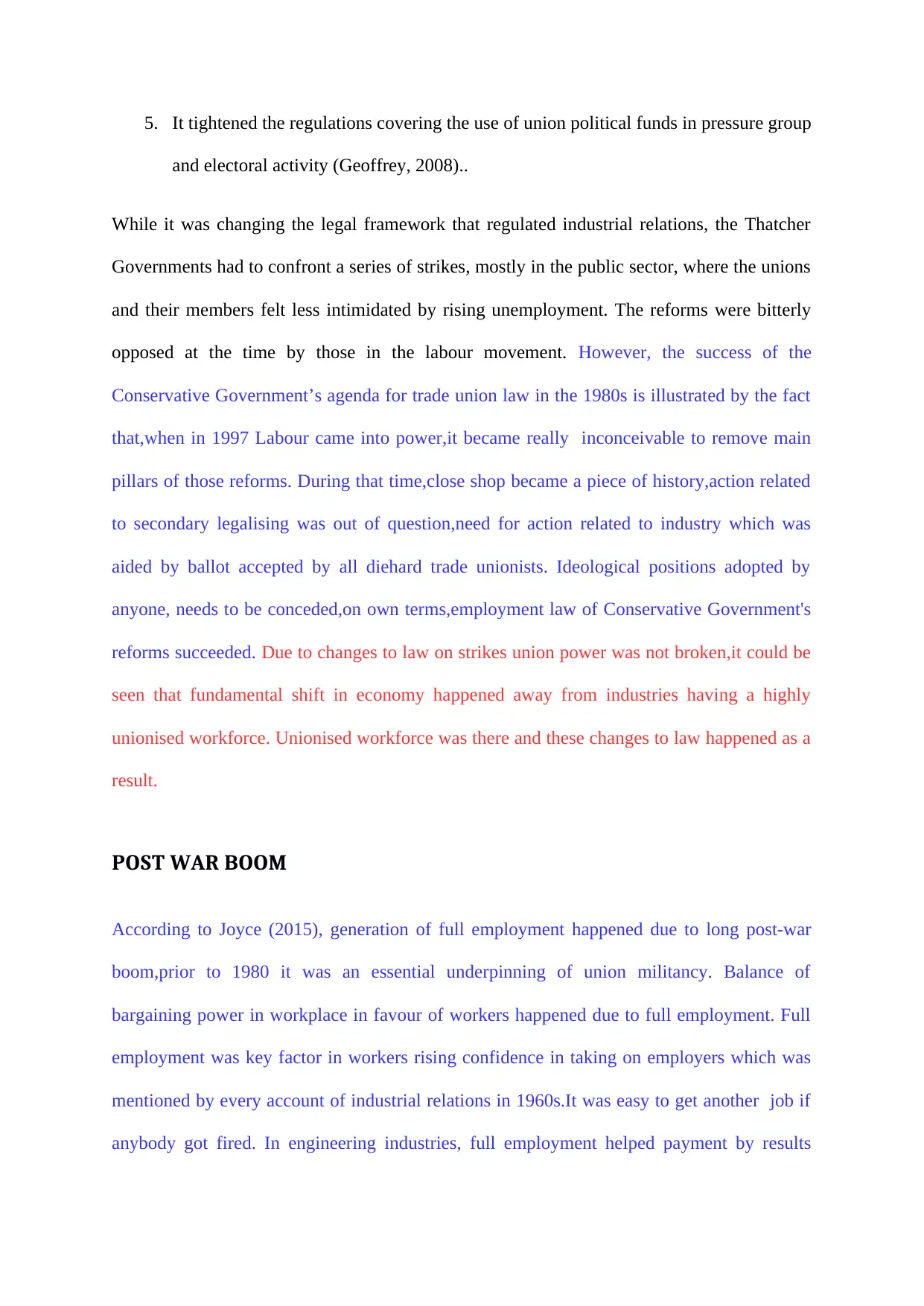
5. It tightened the regulations covering the use of union political funds in pressure group
and electoral activity (Geoffrey, 2008)..
While it was changing the legal framework that regulated industrial relations, the Thatcher
Governments had to confront a series of strikes, mostly in the public sector, where the unions
and their members felt less intimidated by rising unemployment. The reforms were bitterly
opposed at the time by those in the labour movement. However, the success of the
Conservative Government’s agenda for trade union law in the 1980s is illustrated by the fact
that,when in 1997 Labour came into power,it became really inconceivable to remove main
pillars of those reforms. During that time,close shop became a piece of history,action related
to secondary legalising was out of question,need for action related to industry which was
aided by ballot accepted by all diehard trade unionists. Ideological positions adopted by
anyone, needs to be conceded,on own terms,employment law of Conservative Government's
reforms succeeded. Due to changes to law on strikes union power was not broken,it could be
seen that fundamental shift in economy happened away from industries having a highly
unionised workforce. Unionised workforce was there and these changes to law happened as a
result.
POST WAR BOOM
According to Joyce (2015), generation of full employment happened due to long post-war
boom,prior to 1980 it was an essential underpinning of union militancy. Balance of
bargaining power in workplace in favour of workers happened due to full employment. Full
employment was key factor in workers rising confidence in taking on employers which was
mentioned by every account of industrial relations in 1960s.It was easy to get another job if
anybody got fired. In engineering industries, full employment helped payment by results
and electoral activity (Geoffrey, 2008)..
While it was changing the legal framework that regulated industrial relations, the Thatcher
Governments had to confront a series of strikes, mostly in the public sector, where the unions
and their members felt less intimidated by rising unemployment. The reforms were bitterly
opposed at the time by those in the labour movement. However, the success of the
Conservative Government’s agenda for trade union law in the 1980s is illustrated by the fact
that,when in 1997 Labour came into power,it became really inconceivable to remove main
pillars of those reforms. During that time,close shop became a piece of history,action related
to secondary legalising was out of question,need for action related to industry which was
aided by ballot accepted by all diehard trade unionists. Ideological positions adopted by
anyone, needs to be conceded,on own terms,employment law of Conservative Government's
reforms succeeded. Due to changes to law on strikes union power was not broken,it could be
seen that fundamental shift in economy happened away from industries having a highly
unionised workforce. Unionised workforce was there and these changes to law happened as a
result.
POST WAR BOOM
According to Joyce (2015), generation of full employment happened due to long post-war
boom,prior to 1980 it was an essential underpinning of union militancy. Balance of
bargaining power in workplace in favour of workers happened due to full employment. Full
employment was key factor in workers rising confidence in taking on employers which was
mentioned by every account of industrial relations in 1960s.It was easy to get another job if
anybody got fired. In engineering industries, full employment helped payment by results
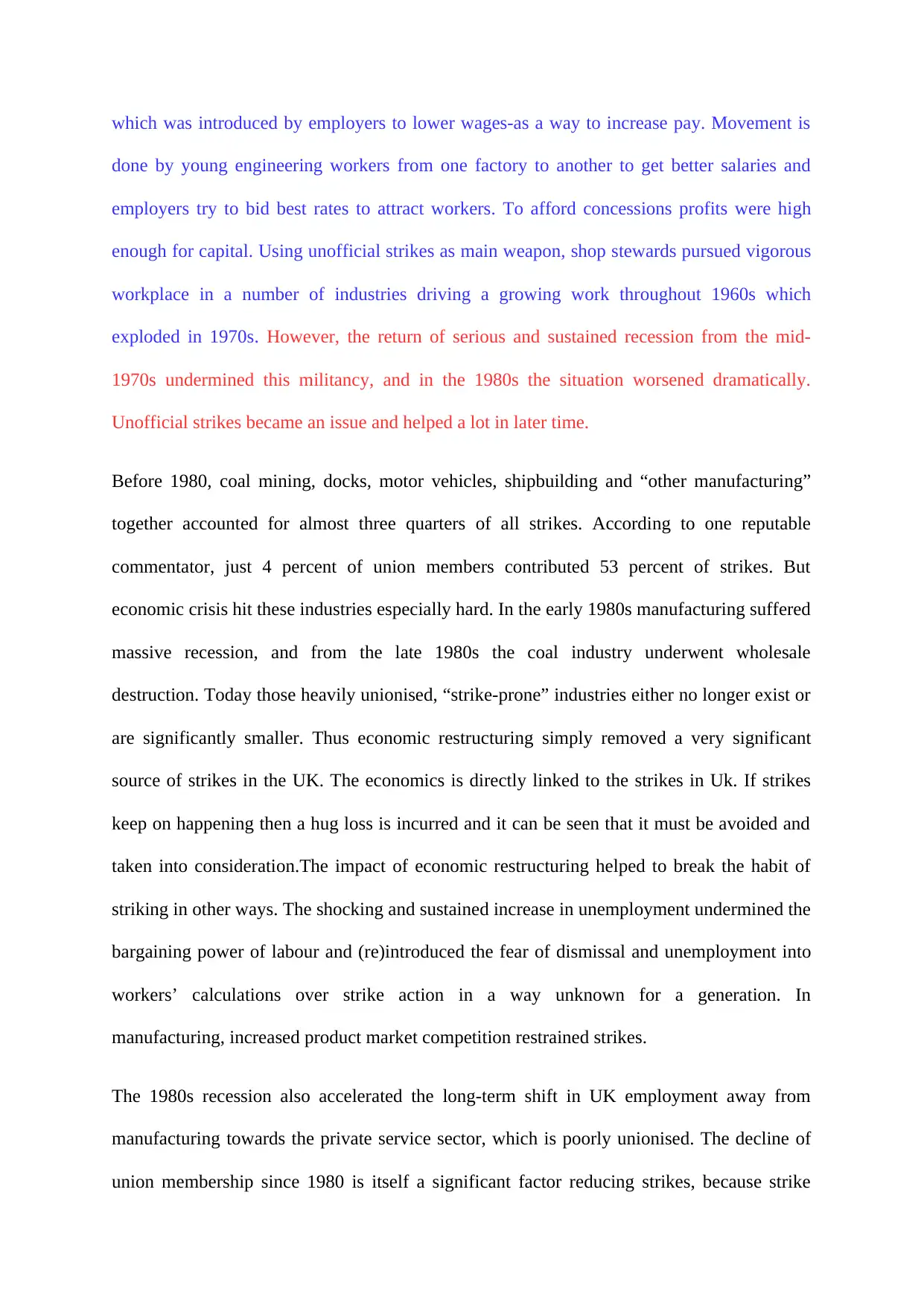
which was introduced by employers to lower wages-as a way to increase pay. Movement is
done by young engineering workers from one factory to another to get better salaries and
employers try to bid best rates to attract workers. To afford concessions profits were high
enough for capital. Using unofficial strikes as main weapon, shop stewards pursued vigorous
workplace in a number of industries driving a growing work throughout 1960s which
exploded in 1970s. However, the return of serious and sustained recession from the mid-
1970s undermined this militancy, and in the 1980s the situation worsened dramatically.
Unofficial strikes became an issue and helped a lot in later time.
Before 1980, coal mining, docks, motor vehicles, shipbuilding and “other manufacturing”
together accounted for almost three quarters of all strikes. According to one reputable
commentator, just 4 percent of union members contributed 53 percent of strikes. But
economic crisis hit these industries especially hard. In the early 1980s manufacturing suffered
massive recession, and from the late 1980s the coal industry underwent wholesale
destruction. Today those heavily unionised, “strike-prone” industries either no longer exist or
are significantly smaller. Thus economic restructuring simply removed a very significant
source of strikes in the UK. The economics is directly linked to the strikes in Uk. If strikes
keep on happening then a hug loss is incurred and it can be seen that it must be avoided and
taken into consideration.The impact of economic restructuring helped to break the habit of
striking in other ways. The shocking and sustained increase in unemployment undermined the
bargaining power of labour and (re)introduced the fear of dismissal and unemployment into
workers’ calculations over strike action in a way unknown for a generation. In
manufacturing, increased product market competition restrained strikes.
The 1980s recession also accelerated the long-term shift in UK employment away from
manufacturing towards the private service sector, which is poorly unionised. The decline of
union membership since 1980 is itself a significant factor reducing strikes, because strike
done by young engineering workers from one factory to another to get better salaries and
employers try to bid best rates to attract workers. To afford concessions profits were high
enough for capital. Using unofficial strikes as main weapon, shop stewards pursued vigorous
workplace in a number of industries driving a growing work throughout 1960s which
exploded in 1970s. However, the return of serious and sustained recession from the mid-
1970s undermined this militancy, and in the 1980s the situation worsened dramatically.
Unofficial strikes became an issue and helped a lot in later time.
Before 1980, coal mining, docks, motor vehicles, shipbuilding and “other manufacturing”
together accounted for almost three quarters of all strikes. According to one reputable
commentator, just 4 percent of union members contributed 53 percent of strikes. But
economic crisis hit these industries especially hard. In the early 1980s manufacturing suffered
massive recession, and from the late 1980s the coal industry underwent wholesale
destruction. Today those heavily unionised, “strike-prone” industries either no longer exist or
are significantly smaller. Thus economic restructuring simply removed a very significant
source of strikes in the UK. The economics is directly linked to the strikes in Uk. If strikes
keep on happening then a hug loss is incurred and it can be seen that it must be avoided and
taken into consideration.The impact of economic restructuring helped to break the habit of
striking in other ways. The shocking and sustained increase in unemployment undermined the
bargaining power of labour and (re)introduced the fear of dismissal and unemployment into
workers’ calculations over strike action in a way unknown for a generation. In
manufacturing, increased product market competition restrained strikes.
The 1980s recession also accelerated the long-term shift in UK employment away from
manufacturing towards the private service sector, which is poorly unionised. The decline of
union membership since 1980 is itself a significant factor reducing strikes, because strike
Paraphrase This Document
Need a fresh take? Get an instant paraphrase of this document with our AI Paraphraser

action is almost always action by unionised workers. By 2013, union density in the private
sector was a little over 14 percent, and union membership roughly half its 1980 level.
Economic restructuring has been an important factor in the decline of union membership as
unionised industries and workplaces have closed and new enterprises have not become
unionised. Decline of union membership has to be taken seriously and new enterprises have
not become unionised.
Within manufacturing, the average size of establishment has greatly reduced, so those private
sector strikes that do occur tend to be smaller. Since 2000 the public and private sectors have
had roughly the same number of strikes, but the public sector has accounted for around 80
percent of days lost because bargaining units are larger. A peak in 2007 saw the public sector
account for 96 percent of all strike days.
The impact of economic restructuring helped to break the habit of striking in other ways. The
shocking and sustained increase in unemployment undermined the bargaining power of
labour and (re)introduced the fear of dismissal and unemployment into workers’ calculations
over strike action in a way unknown for a generation. In manufacturing, increased product
market competition restrained strikes. The onset of economic crisis also saw the rise of the
“viability argument”, i.e the argument that if the company doesn’t make a profit it will close
and the workers will lose their jobs.
DEFEAT OF OBSTINATE UNIONS
The 1980s have been accurately described as a period of “coercive pacification” of the
unions. Employers used the pressure of recession and the new laws backed by the power of
the state to inflict a series of devastating defeats on workers and their unions. This had a
significant “demonstration effect”, whereby each defeat discourages others from the risk of a
sector was a little over 14 percent, and union membership roughly half its 1980 level.
Economic restructuring has been an important factor in the decline of union membership as
unionised industries and workplaces have closed and new enterprises have not become
unionised. Decline of union membership has to be taken seriously and new enterprises have
not become unionised.
Within manufacturing, the average size of establishment has greatly reduced, so those private
sector strikes that do occur tend to be smaller. Since 2000 the public and private sectors have
had roughly the same number of strikes, but the public sector has accounted for around 80
percent of days lost because bargaining units are larger. A peak in 2007 saw the public sector
account for 96 percent of all strike days.
The impact of economic restructuring helped to break the habit of striking in other ways. The
shocking and sustained increase in unemployment undermined the bargaining power of
labour and (re)introduced the fear of dismissal and unemployment into workers’ calculations
over strike action in a way unknown for a generation. In manufacturing, increased product
market competition restrained strikes. The onset of economic crisis also saw the rise of the
“viability argument”, i.e the argument that if the company doesn’t make a profit it will close
and the workers will lose their jobs.
DEFEAT OF OBSTINATE UNIONS
The 1980s have been accurately described as a period of “coercive pacification” of the
unions. Employers used the pressure of recession and the new laws backed by the power of
the state to inflict a series of devastating defeats on workers and their unions. This had a
significant “demonstration effect”, whereby each defeat discourages others from the risk of a

strike. Defeats such as that of the steel workers, wapping, the dockers and, above all, the
year-long miners’ strike had a huge demoralising effect (Lyddon, 2007).
From the mid-1980s employers started to dismiss strikers. Most prominent was the sacking of
5,500 workers at Wapping, but other examples include P&O Ferries and the Liverpool
dockers. Between 1986 and 1989 dismissal of strikers was used at least 45 times and
threatened 38 times. There was a growing perception of the vulnerability of workers taking
industrial action. Official ballot papers must by law contain a warning that striking “may be
in breach of your contract”. Dismissals of strikers continue, such as at Gate Gourmet in 2005
and selective sackings of BA cabin crew during the 2009-2010 dispute. Other sanctions have
included loss of redundancy pay.
Without any surprise, without backing of union workers lost confidence,reducing unofficial
strikes even before they were legally stopped. Great majority is of official strikes. Defeats
had effects on union officials. De-prioritisation of industrial action in dealing with employers
by unions, strategies of concession and compromise or “new realism”—a phrase first used in
1983 was opted. Unions sought explicit partnership agreements from mid-1990s,wherever
possible strike should be avoided and membership rebuilding and collaborative employers
relationship must be maintained. Strikes were causing problems and better relationships were
to be maintain.
TRADE LIBERALISATION AND GLOBALISATION
Accounting for decline of collective industrial actions in manufacturing is affected by trade
liberalisation and globalisation. In increasing global market place intensifying competition
pressures helps to explain demise of many larger workplaces where collective action took
year-long miners’ strike had a huge demoralising effect (Lyddon, 2007).
From the mid-1980s employers started to dismiss strikers. Most prominent was the sacking of
5,500 workers at Wapping, but other examples include P&O Ferries and the Liverpool
dockers. Between 1986 and 1989 dismissal of strikers was used at least 45 times and
threatened 38 times. There was a growing perception of the vulnerability of workers taking
industrial action. Official ballot papers must by law contain a warning that striking “may be
in breach of your contract”. Dismissals of strikers continue, such as at Gate Gourmet in 2005
and selective sackings of BA cabin crew during the 2009-2010 dispute. Other sanctions have
included loss of redundancy pay.
Without any surprise, without backing of union workers lost confidence,reducing unofficial
strikes even before they were legally stopped. Great majority is of official strikes. Defeats
had effects on union officials. De-prioritisation of industrial action in dealing with employers
by unions, strategies of concession and compromise or “new realism”—a phrase first used in
1983 was opted. Unions sought explicit partnership agreements from mid-1990s,wherever
possible strike should be avoided and membership rebuilding and collaborative employers
relationship must be maintained. Strikes were causing problems and better relationships were
to be maintain.
TRADE LIBERALISATION AND GLOBALISATION
Accounting for decline of collective industrial actions in manufacturing is affected by trade
liberalisation and globalisation. In increasing global market place intensifying competition
pressures helps to explain demise of many larger workplaces where collective action took
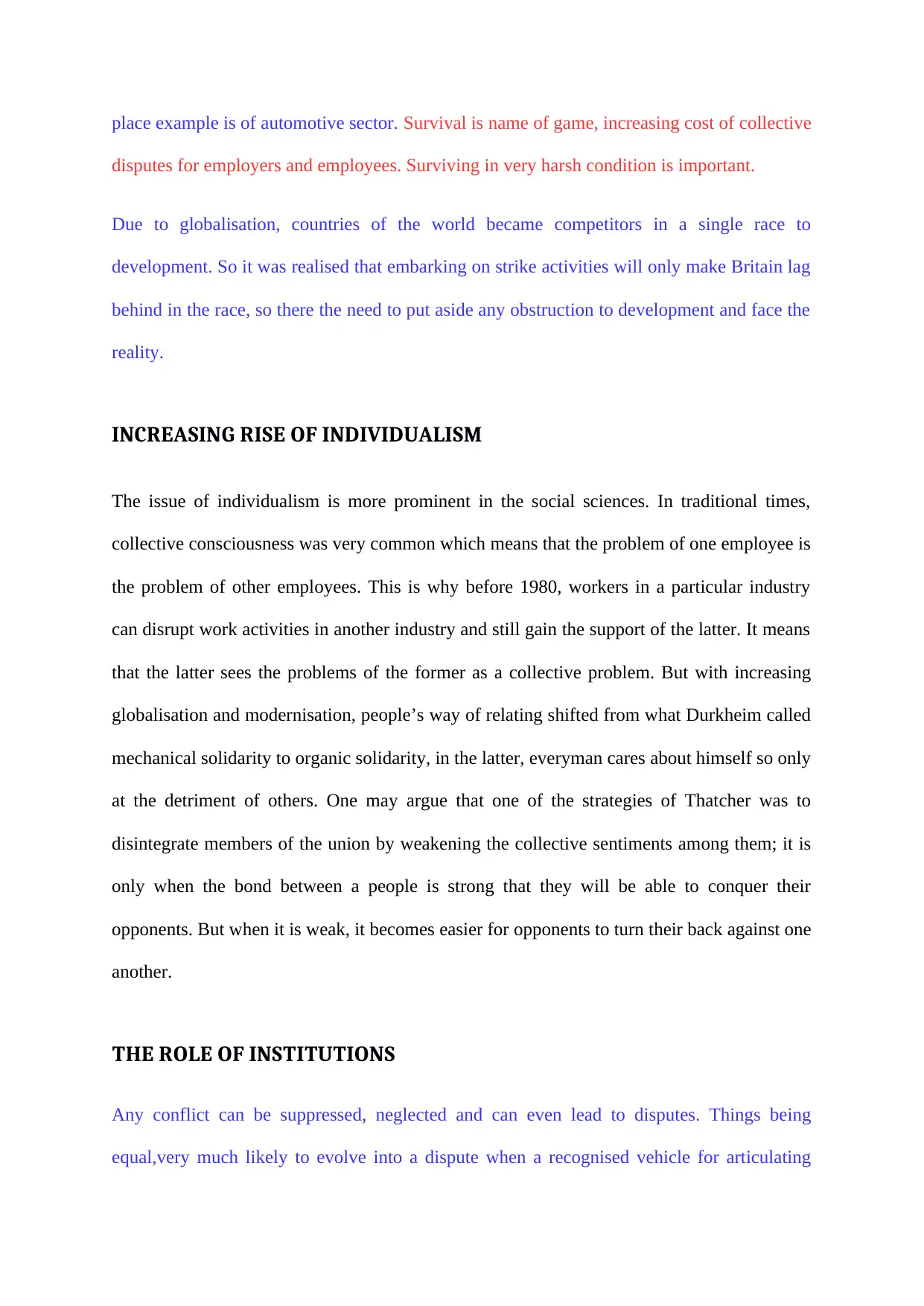
place example is of automotive sector. Survival is name of game, increasing cost of collective
disputes for employers and employees. Surviving in very harsh condition is important.
Due to globalisation, countries of the world became competitors in a single race to
development. So it was realised that embarking on strike activities will only make Britain lag
behind in the race, so there the need to put aside any obstruction to development and face the
reality.
INCREASING RISE OF INDIVIDUALISM
The issue of individualism is more prominent in the social sciences. In traditional times,
collective consciousness was very common which means that the problem of one employee is
the problem of other employees. This is why before 1980, workers in a particular industry
can disrupt work activities in another industry and still gain the support of the latter. It means
that the latter sees the problems of the former as a collective problem. But with increasing
globalisation and modernisation, people’s way of relating shifted from what Durkheim called
mechanical solidarity to organic solidarity, in the latter, everyman cares about himself so only
at the detriment of others. One may argue that one of the strategies of Thatcher was to
disintegrate members of the union by weakening the collective sentiments among them; it is
only when the bond between a people is strong that they will be able to conquer their
opponents. But when it is weak, it becomes easier for opponents to turn their back against one
another.
THE ROLE OF INSTITUTIONS
Any conflict can be suppressed, neglected and can even lead to disputes. Things being
equal,very much likely to evolve into a dispute when a recognised vehicle for articulating
disputes for employers and employees. Surviving in very harsh condition is important.
Due to globalisation, countries of the world became competitors in a single race to
development. So it was realised that embarking on strike activities will only make Britain lag
behind in the race, so there the need to put aside any obstruction to development and face the
reality.
INCREASING RISE OF INDIVIDUALISM
The issue of individualism is more prominent in the social sciences. In traditional times,
collective consciousness was very common which means that the problem of one employee is
the problem of other employees. This is why before 1980, workers in a particular industry
can disrupt work activities in another industry and still gain the support of the latter. It means
that the latter sees the problems of the former as a collective problem. But with increasing
globalisation and modernisation, people’s way of relating shifted from what Durkheim called
mechanical solidarity to organic solidarity, in the latter, everyman cares about himself so only
at the detriment of others. One may argue that one of the strategies of Thatcher was to
disintegrate members of the union by weakening the collective sentiments among them; it is
only when the bond between a people is strong that they will be able to conquer their
opponents. But when it is weak, it becomes easier for opponents to turn their back against one
another.
THE ROLE OF INSTITUTIONS
Any conflict can be suppressed, neglected and can even lead to disputes. Things being
equal,very much likely to evolve into a dispute when a recognised vehicle for articulating
Secure Best Marks with AI Grader
Need help grading? Try our AI Grader for instant feedback on your assignments.

concerns employees believe resolving issue at stake. Kersley pointed out, procedures to
manage disputes between managers and employees been a feature of workplace changes from
last twenty five years,having a growth in arrangements which is in collective and individual
conflict. By 2004, trade unions had a formal procedure for handling collective disputes and
its percentage was around 78% workplaces felt it. Formal procedures for dealing with
individual grievances(88%) was present in workplaces at greater proportions and disciplinary
matters (91%) and, even it could be seen that, both procedure types were universal in
workplaces having one or many recognised union. A procedure for handling disputes was
discovered here and became efficient later on.
In the case of collective disputes, there is little evidence to suggest that the increased
availability of institutional procedures has been a major factor in determining either the level
or form that conflict has taken. Most workplaces exhibiting high levels of collective action in
the earlier part of our period, above all in the metalworking sectors, were well-known for
their disputes procedures. The same is true of the public sector organizations that have made
the major contribution to the pattern in recent years. Formal procedures may not prevent
strikes occurring, though they may well be a necessary feature in resolving disputes once they
occur (Blanchflower and Cubbin, 1986). Similarly, the presence of individual disputes
procedures does not appear to help in the avoidance of strikes, but instead provides a means
by which discontent can be articulated and the resulting conflict addressed. Knight and
Latreille, for instance, found that the presence of a formal disciplinary procedure had little
bearing on whether or not a workplace had been subject to an Employment Tribunal claim
(Knight and Latreille, 2000). Accordingly, sectors with a high incidence of grievance and
disciplinary procedures will not necessarily see low levels of individual disputes.
Nevertheless, procedures are an important, if not sufficient, condition for the formal
expression and resolution of conflict by employees. If there are no collective disputes or
manage disputes between managers and employees been a feature of workplace changes from
last twenty five years,having a growth in arrangements which is in collective and individual
conflict. By 2004, trade unions had a formal procedure for handling collective disputes and
its percentage was around 78% workplaces felt it. Formal procedures for dealing with
individual grievances(88%) was present in workplaces at greater proportions and disciplinary
matters (91%) and, even it could be seen that, both procedure types were universal in
workplaces having one or many recognised union. A procedure for handling disputes was
discovered here and became efficient later on.
In the case of collective disputes, there is little evidence to suggest that the increased
availability of institutional procedures has been a major factor in determining either the level
or form that conflict has taken. Most workplaces exhibiting high levels of collective action in
the earlier part of our period, above all in the metalworking sectors, were well-known for
their disputes procedures. The same is true of the public sector organizations that have made
the major contribution to the pattern in recent years. Formal procedures may not prevent
strikes occurring, though they may well be a necessary feature in resolving disputes once they
occur (Blanchflower and Cubbin, 1986). Similarly, the presence of individual disputes
procedures does not appear to help in the avoidance of strikes, but instead provides a means
by which discontent can be articulated and the resulting conflict addressed. Knight and
Latreille, for instance, found that the presence of a formal disciplinary procedure had little
bearing on whether or not a workplace had been subject to an Employment Tribunal claim
(Knight and Latreille, 2000). Accordingly, sectors with a high incidence of grievance and
disciplinary procedures will not necessarily see low levels of individual disputes.
Nevertheless, procedures are an important, if not sufficient, condition for the formal
expression and resolution of conflict by employees. If there are no collective disputes or

grievance procedures, workers are less likely to be able to raise their concerns within the
workplace and so are more likely to ‘resolve’ the conflictual situation by quitting.
CONCLUSION
Declining strike activities in Britain is a product of serious social reform that lasted for years.
Some of the points discussed in this paper were actually primary and could be described as
classical reasons for the decline of strike activities in Britain; this is because they laid the
foundation for other forces. The reform by Thatcher administration, defeat of unions, post
war boom and deflation for example laid the foundation for secondary and continuous forces
such as increasing individualism and globalisation. Deflation produced secondary and
continuous forces which is of great importance.
workplace and so are more likely to ‘resolve’ the conflictual situation by quitting.
CONCLUSION
Declining strike activities in Britain is a product of serious social reform that lasted for years.
Some of the points discussed in this paper were actually primary and could be described as
classical reasons for the decline of strike activities in Britain; this is because they laid the
foundation for other forces. The reform by Thatcher administration, defeat of unions, post
war boom and deflation for example laid the foundation for secondary and continuous forces
such as increasing individualism and globalisation. Deflation produced secondary and
continuous forces which is of great importance.
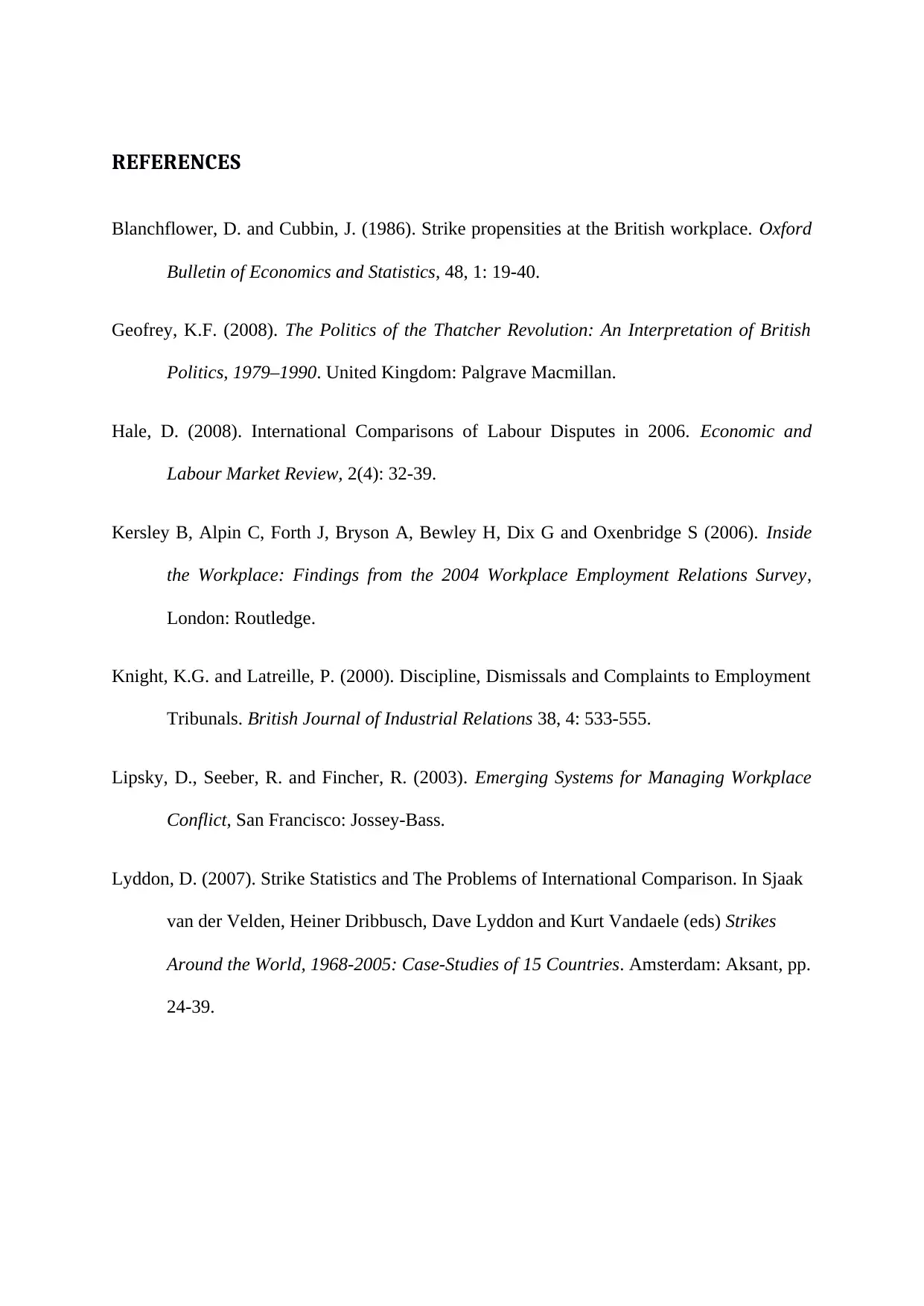
REFERENCES
Blanchflower, D. and Cubbin, J. (1986). Strike propensities at the British workplace. Oxford
Bulletin of Economics and Statistics, 48, 1: 19-40.
Geofrey, K.F. (2008). The Politics of the Thatcher Revolution: An Interpretation of British
Politics, 1979–1990. United Kingdom: Palgrave Macmillan.
Hale, D. (2008). International Comparisons of Labour Disputes in 2006. Economic and
Labour Market Review, 2(4): 32-39.
Kersley B, Alpin C, Forth J, Bryson A, Bewley H, Dix G and Oxenbridge S (2006). Inside
the Workplace: Findings from the 2004 Workplace Employment Relations Survey,
London: Routledge.
Knight, K.G. and Latreille, P. (2000). Discipline, Dismissals and Complaints to Employment
Tribunals. British Journal of Industrial Relations 38, 4: 533-555.
Lipsky, D., Seeber, R. and Fincher, R. (2003). Emerging Systems for Managing Workplace
Conflict, San Francisco: Jossey-Bass.
Lyddon, D. (2007). Strike Statistics and The Problems of International Comparison. In Sjaak
van der Velden, Heiner Dribbusch, Dave Lyddon and Kurt Vandaele (eds) Strikes
Around the World, 1968-2005: Case-Studies of 15 Countries. Amsterdam: Aksant, pp.
24-39.
Blanchflower, D. and Cubbin, J. (1986). Strike propensities at the British workplace. Oxford
Bulletin of Economics and Statistics, 48, 1: 19-40.
Geofrey, K.F. (2008). The Politics of the Thatcher Revolution: An Interpretation of British
Politics, 1979–1990. United Kingdom: Palgrave Macmillan.
Hale, D. (2008). International Comparisons of Labour Disputes in 2006. Economic and
Labour Market Review, 2(4): 32-39.
Kersley B, Alpin C, Forth J, Bryson A, Bewley H, Dix G and Oxenbridge S (2006). Inside
the Workplace: Findings from the 2004 Workplace Employment Relations Survey,
London: Routledge.
Knight, K.G. and Latreille, P. (2000). Discipline, Dismissals and Complaints to Employment
Tribunals. British Journal of Industrial Relations 38, 4: 533-555.
Lipsky, D., Seeber, R. and Fincher, R. (2003). Emerging Systems for Managing Workplace
Conflict, San Francisco: Jossey-Bass.
Lyddon, D. (2007). Strike Statistics and The Problems of International Comparison. In Sjaak
van der Velden, Heiner Dribbusch, Dave Lyddon and Kurt Vandaele (eds) Strikes
Around the World, 1968-2005: Case-Studies of 15 Countries. Amsterdam: Aksant, pp.
24-39.
1 out of 13
Your All-in-One AI-Powered Toolkit for Academic Success.
+13062052269
info@desklib.com
Available 24*7 on WhatsApp / Email
![[object Object]](/_next/static/media/star-bottom.7253800d.svg)
Unlock your academic potential
© 2024 | Zucol Services PVT LTD | All rights reserved.